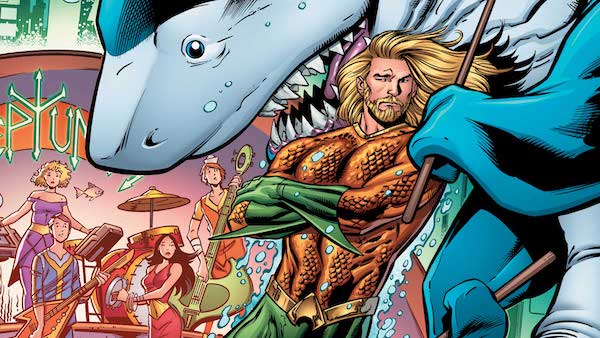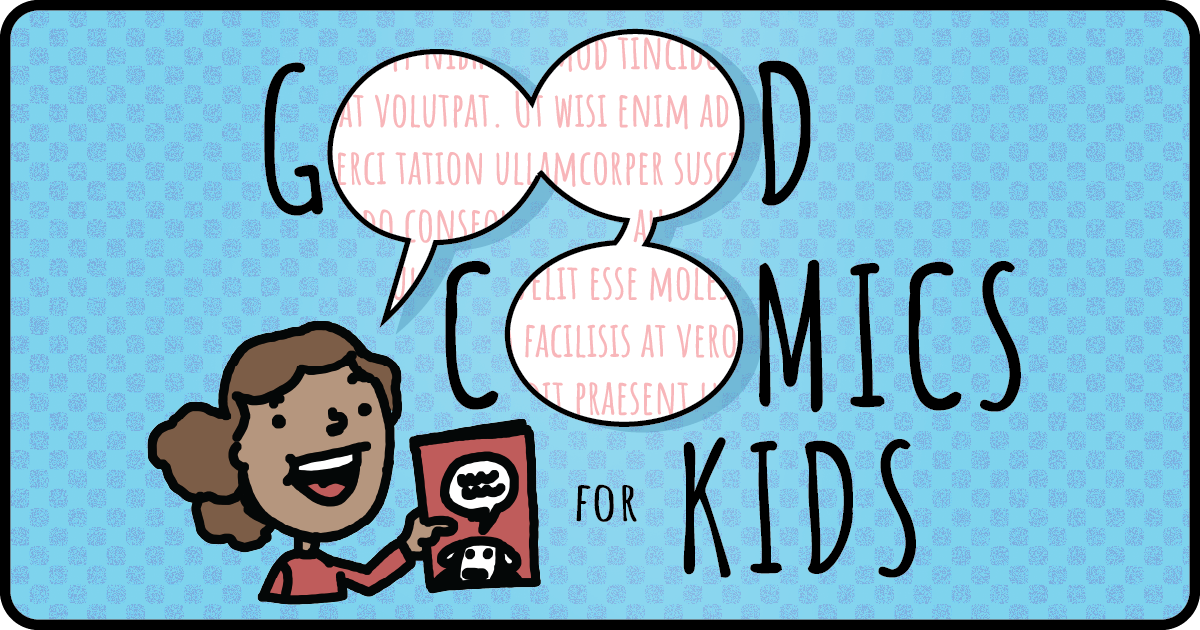
Review: 2018’s DC/Hanna-Barbera crossover specials
Last spring, DC Comics released a series of four one-shot crossovers between their own characters Green Lantern, Adam Strange, Booster Gold and The Suicide Squad with some fairly random Hanna-Barbera characters: Space Ghost, The Flintstones, The Banana Splits and Jonny Quest and others. While the major comics publishers are notoriously reticent to discuss sales data, it’s safe to assume those specials were a pretty big success. After all, they decided to do another round of them.
As with the first round, the only really consistent aspect between these four is that they are extremely weird. The title superheroes—Aquaman, Black Lightning, The Flash, and Superboy and Robin—are more top-tier than those from the 2017 crossovers, and the same goes for the Hanna-Barbera characters—Jabberjaw, Hong Kong Phooey, Blue Falcon and Dynomutt, and Speed Buggy. All four continue the trend of redesigning the Hanna-Barbera cartoon characters to look more like they “belong” in the DC Universe, filtering them through the publisher’s house style to make them look more realistic (usually to highly disturbing effect), and all are produced by regular creators who work with the publisher month in and month out.
ADVERTISEMENT
ADVERTISEMENT
Otherwise, they tend to have little in common. Some have back-ups, some don’t. Some feature the Hanna-Barbera visitor coming to the DCU from a different dimension, others posit that the characters have always cohabitated within the same milieu. Some stick close to the original conception of the characters’ personalities, others veer wildly off.
 The best of them is Aquaman/Jabberjaw Special #1, which is written by regular Aquaman writer Dan Abnett and drawn by pencil artist Paul Pelletier and inker Andrew Hennessy. The title character of the 1976 show, Jabberjaw was the talking shark drummer for the human rock band The Neptunes, who constantly toured the underwater civilization of 2076, where they ran into supervillains of one kind or another at a rate of about one per episode.
The best of them is Aquaman/Jabberjaw Special #1, which is written by regular Aquaman writer Dan Abnett and drawn by pencil artist Paul Pelletier and inker Andrew Hennessy. The title character of the 1976 show, Jabberjaw was the talking shark drummer for the human rock band The Neptunes, who constantly toured the underwater civilization of 2076, where they ran into supervillains of one kind or another at a rate of about one per episode.
Abnett sets the story up as a sort of answer to Jaws—which, given the timing, likely indirectly inspired Jabberjaw in the first place—with Aquaman being asked to help deal with a giant great white shark seen along the beaches of Amnesty Bay. The shark proves easy to find, though, as he’s just walking around a grocery store. This is, of course, Jabberjaw, who is simply drawn to resemble a real shark, the incongruity of the Curly Howard-esque dialogue (with a bit of Rodney Dangerfield thrown in) coming from the blank-eyed shark face being even more effective than if he looked more like “himself.”
Together the pair discover a threat to Aquaman’s world coming from a portal from Jabberjaw’s, and they travel to the Aqualand of 2076 to deal with it, where Aquaman briefly meets The Neptunes. Beyond the many obvious gags, Abnett is able to find a deeper, more central character trait the two characters share and exploit that in such a way to make this into a genuinely compelling Aquaman story. Regardless of Jabberjaw’s catchphrase and Aquaman’s long-suffering attempts to live down all the pop culture stereotypes about him, I have a lot of respect for this comic. (This one includes an eight-page back-up story by writer Jeff Parker and Scott Kolins, in which The Spectre and The Wizard Shazam bring a caveman into the present during a cosmic debate about the inherent heroism of humanity, and said caveman turns out to be Captain Caveman).
 For Black Lightning/Hong Kong Phooey Special #1, writer Bryan Hill embraces the characters’ potentially problematical elements by setting his story in the 1970s. Black Lightning debuted in 1977, as DC’s superhero answer to blaxploitation films (school teacher Jefferson Pierce’s costume included a mask attached to an afro wig), while Hong Kong Phooey’s 1974 show sought to exploit the kung fu craze of the decade by starring a canine superhero who fought crime with martial arts learned from the Hong Kong Book of Kung Fu.
For Black Lightning/Hong Kong Phooey Special #1, writer Bryan Hill embraces the characters’ potentially problematical elements by setting his story in the 1970s. Black Lightning debuted in 1977, as DC’s superhero answer to blaxploitation films (school teacher Jefferson Pierce’s costume included a mask attached to an afro wig), while Hong Kong Phooey’s 1974 show sought to exploit the kung fu craze of the decade by starring a canine superhero who fought crime with martial arts learned from the Hong Kong Book of Kung Fu.
This is basically a Black Lightning comic set back when he was still rocking his “disco suit.” A couple of martial arts characters have teamed up with a Hong Kong Phooey villain to steal a powerful scroll of dark martial arts magic, and so B.L. turns to his old friend Penrod, who is a martial arts dog man for some reason that is never touched on. The idea of putting these two together is a good gag in and of itself, and Denys Cowan and Bill Sienkiewicz’s art is superior, but there’s nothing really to the comic, beyond the fact that it exists at all. (The short back-up, again by Parker and Kolins, features about six panels of Jason Blood, who is only there to raise the spirit of a founding father—The Funky Phantom. This comic is noteworthy for how political it is; it’s basically an anti-gun comic, which is actually pretty remarkable given how shy publishers like DC can be when it comes to potentially provocative issues—even when they are as common sense as, say, 18th century Americans could have never imagined an AR-15.)
 Perhaps the weirdest of the comics is the Super Sons/Dynomutt Special #1. It’s written by Super Sons writer Peter Tomasi, who had decent-sized runs writing both of the Super Sons, Robin Damian Wayne and Superboy Jonathan Kent. There’s a pretty clever element, in which Robin reveals that Blue Falcon is an old ally of Batman’s and was even part of the Batman, Inc initiative, which makes sense, given that the 1976-launched Dynomutt, Dog Wonder cartoon was a parody of the Batman TV show of the late 1960s.
Perhaps the weirdest of the comics is the Super Sons/Dynomutt Special #1. It’s written by Super Sons writer Peter Tomasi, who had decent-sized runs writing both of the Super Sons, Robin Damian Wayne and Superboy Jonathan Kent. There’s a pretty clever element, in which Robin reveals that Blue Falcon is an old ally of Batman’s and was even part of the Batman, Inc initiative, which makes sense, given that the 1976-launched Dynomutt, Dog Wonder cartoon was a parody of the Batman TV show of the late 1960s.
The Kent family is attending a funeral in Big City, home of The Blue Falcon and Dynomutt, and Robin tracks his friend Jonathan there out of boredom. When they are approached by a badly damaged and dying Dynomutt, they become embroiled in a shockingly violent adventure involving a brainwashed Blue Falcon, intent on killing his bionic dog sidekick at the command of one of his villains. (They push the “T for Teen” rating, in this incongruously adult comic; the villain, for example, wants to eat the heroes’ corpses.)
ADVERTISEMENT
ADVERTISEMENT
At the risk of spoiling things, Dynomutt does not die, but Blue Falcon does…only to be resurrected via the same technology that turned the once living Dynomutt into the Dog Wonder. Tomasi spends a lot of time on the dynamic between the two characters, adding a tragic backstory, but doesn’t seem to “get” either of them at all, as neither sounds or acts at all like the characters from the cartoons in the least. Pencil artist Fernando Pasarin, working with inker Oclair Albert, similarly weirdly avoids drawing the characters in any way that approaches their cartoon designs, with the realistic version of Dynomutt’s robot business often looking pretty unsettling.
 Finally, The Flash/Speed Buggy Special #1 by writer Scott Lobdell and pencil artist Brett Booth pairs the speedster with the title character from the shortlived 1973 Speed Buggy, an anthropomorphic dune buggy that solved mysteries with a trio of teenagers while traveling the world to compete in races. As with the Aquaman and Jabberjaw pairing, this one is a pretty obvious no-brainer.
Finally, The Flash/Speed Buggy Special #1 by writer Scott Lobdell and pencil artist Brett Booth pairs the speedster with the title character from the shortlived 1973 Speed Buggy, an anthropomorphic dune buggy that solved mysteries with a trio of teenagers while traveling the world to compete in races. As with the Aquaman and Jabberjaw pairing, this one is a pretty obvious no-brainer.
Which isn’t to say that Lobdell doesn’t make some unusual decisions. Firstly, he chooses the Wally West version of The Flash as opposed to the Barry Allen version, meaning this probably isn’t quite as new-reader friendly as it could be. Additionally, the focus of the story is the secret origin of Speed Buggy in the DC Universe, so much of the comic is focused on the tragic story of a super-scientist who sacrifices his human form in order to save the world, dooming himself to life as a talking car in the process.
Booth’s radical redesign of Speed Buggy makes him nigh unrecognizable, which is unfortunate only in that there are evil opposite versions of the character introduced, but since the baseline is itself so new, these variations don’t have much impact. The epilogue, in which The Flash and Speed Buggy race for charity, is on much surer footing, and gives Booth an excuse to draw all the Hanna-Barbera characters he can fit in the bleachers, rubbing shoulders with all the DC superheroes he wants.
Given that, on the whole, this round of crossovers is superior to last year’s, I wouldn’t be surprised to see another quartet of DC/Hanna-Barbera crossovers come spring of 2019.
Filed under: Reviews, Young Adult
About J. Caleb Mozzocco
J. Caleb Mozzocco is a way-too-busy freelance writer who has written about comics for online and print venues for a rather long time now. He currently contributes to Comic Book Resources' Robot 6 blog and ComicsAlliance, and maintains his own daily-ish blog at EveryDayIsLikeWednesday.blogspot.com. He lives in northeast Ohio, where he works as a circulation clerk at a public library by day.
ADVERTISEMENT
ADVERTISEMENT
SLJ Blog Network
One Star Review, Guess Who? (#202)
This Q&A is Going Exactly As Planned: A Talk with Tao Nyeu About Her Latest Book
Parsing Religion in Public Schools
Take Five: LGBTQIA+ Middle Grade Novels
ADVERTISEMENT








